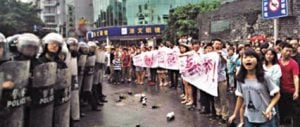China’s “environmental storms”, a spate of high profile crackdowns on illegal polluters eight years ago, have faded into history. Back then, a new law on environmental impact assessments gave the otherwise weak State Environmental Protection Agency (SEPA) the tools to stop law-breakers in their tracks. The agency halted 30 major projects, worth almost 118 billion yuan (US$19 billion), and many hoped it was only the start.
It was not. After SEPA was upgraded in status, becoming the Ministry of Environmental Protection in 2008, the storms died away. In the following years, there was much less supervision and momentum from the environmental wing of government, and China’s environment continued to worsen.
Instead, public participation in mass environmental campaigns came to the fore. In 2007, the people of the east coast port of Xiamen marched through the city to protest against a PX chemical plant, starting a new trend of large-scale environmental campaigns. In Dalian, Shifang and Qidong too, this is how the environment was protected: by tens of thousands taking to the streets.
Also see: China’s new “middle class” environmental protests
In 10 years, environmental management in China has shifted from being a matter of top-down law enforcement to one of bottom-up public campaigning. This marks a failure of environmental management in China, founded on structural problems. Simply strengthening the arm of the law will not solve the problem.
Squeezed private businesses create pollution “disaster zones”
Businesses sacrifice the environment in pursuit of profit primarily because economic structures force them to do so. The global economy squeezes the profits of Chinese firms, while domestically almost all the sectors where large profits can easily be made – finance, energy, communications, transport – are dominated by state-owned firms. China’s numerous private businesses are pushed into a limited number of industries, leading to excessive and destructive competition.
With slim profits, it is natural that companies sacrifice the environment to cut costs. As a result, the food, paper and small-scale manufacturing industries are turned into disaster zones for workplace safety and pollution.
Then there’s the problem of local law enforcement.
China’s green legislation is improving on paper, but turning that progress into reality at local level remains a battle. Local officials are meant to represent the state and society in combating pollution but, without oversight or constraints, often become agents of the law-breakers instead, engaging in an alliance with polluters where they use the threat of legal powers to extract benefits from them.
Areas which rely heavily on local law enforcement, such as food safety and environmental management, are particularly prone to this trap. Clearer and tougher laws may only strengthen the position of local officials when negotiating with business. Perversely, stronger legislation may actually make things worse.
Environmental groups unable to represent the public
Routes to judicial redress have also been blocked, with no legislation allowing environmental groups to bring cases on behalf of the public. This means most activists push hard on environmental education and advocacy, but are unable to protect the environment on behalf of residents. Worse, the system obstructs the registration and operation of environmental groups. So these groups, which should represent and mediate between the people and the government, are unable to play their role, leaving the public to go it alone.
With neither the government nor environmental groups able to play their part, a new environmental force has taken the stage – direct and spontaneous public campaigns. In China, the “environmental movement” used to mean lobbying from NGOs, reporters, academics and university students. Now it includes ordinary people in large-scale street protests.
It was only after SEPA’s crackdowns were over that the country saw this wave of environmental campaigns. China’s street protests are a case of the people taking power into their own hands after environmental management by the government has failed.
Participants in the public protests of recent years have been mainly locals. The cases are very similar, and are becoming more frequent and intense. They rely heavily on new forms of media, as people use social networking to form groups, creating a form of community protest. In Dalian and Shifang, such protests changed government decisions, relieving to some extent the risks of pollution.
Street protests won’t change the system
Of course, there are also problems. Mass movements can radicalise. The speed of microblogs and the ease with which they bring people together allows for personal and emotional reactions to be exaggerated. Irrational ideas are easily spread and emboldened. And the decentralised nature of these discussions makes it harder to control public opinion.
More important is the fact that, no matter how loud these protests are, they don’t change the system. Many projects have been stopped due to mass protests, but decision-making methods stay the same, as does the power of developers.
China’s so-called environmental movement looks passive – it is dependent on how the government reacts. If the reaction is poor, so will be the outcomes for the movement. You could say that the quality of China’s environmental movement depends on the quality of its participants, while its outcome depends on the quality of government. This way of protecting the environment offers no guarantees.
The good news is that these campaigns show the Chinese people are getting more involved in the environment. I hope grassroots participation can help to trigger true reform of the system.



